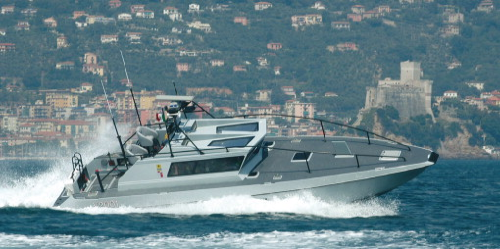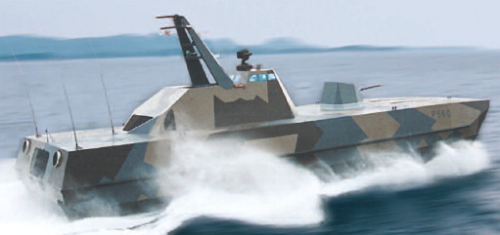

Although military and paramilitary forces generally prefer to stay with the familiar and well-proven virtues of metal – except for minehunters where a low magnetic signature is required – composites are increasingly favoured for small, very fast craft. Drug runners and other criminals, terrorists and hostile infiltrators equip themselves with fast powerboats that easily outpace conventional military craft and similar vessels operated by most customs, police and other authorities. In response, there has evolved a demand for high-speed interceptors and other enforcement craft. Engineering hulls strong and stiff enough to maintain speeds in a seaway of 50 kts or more is a challenge for which advanced composites are well suited. Offshore powerboat specialists Cougar Marine and FB Design, for example, have based fast, high-tech chasers on raceboat-derived technology. Cougar came together with military craft expert VT-Halmatic in the Halmatic-Cougar Alliance to produce the Enforcer range of patrol craft. Powered by twin inboard diesels or twin/triple outboards, Enforcer 33, 40 or 46 models can reach speeds in excess of 60 kts, thanks to their light composite V planing hulls. The Enforcer 33 is proven in service with the Royal Oman Police Coastguard while the Enforcer 40 provides coastal law enforcement for at least two coastguard agencies. Enforcer 46, a powerful air-portable special operations craft based on Cougar's successful US1 raceboat, has seen service with the UK Ministry of Defence. The monohull range is complemented by a 28 ft catamaran, the Cat 900, that can exceed 50 kts in high-speed coastal and estuary patrol roles.
All these craft are composite. The Enforcer 33 sets the tone with a monocoque deck/hull laminated from glass and aramid fabrics laid up in isophthalic polyester resin. The shell is reinforced internally with longitudinal structural foam core stiffeners. High vertical accelerations expected at the hull bottom prompted specification of a monolithic glass/aramid/epoxy bottom shell, with selective carbon reinforcement, and glass/epoxy/foam-core sandwich for the topsides and deck. Famous Italian powerboat designer and racer Fabio Buzzi has his initials immortalised in the FB Design company that has been responsible for a range of fast powerboats between 38 ft and 55 ft long. Craft capable of 60 kts plus have been produced for the Guardia di Finanza in Italy, plus the police and customs services of Hong Kong. Advanced hull forms developed by Buzzi are produced in glass and hybrid composites. A significant Buzzi innovation is FB Design's STAB (stability) system, in which the inflatable collar that characterises a RIB has been ‘shrunk’ to a couple of stabilising sections mounted on the after half of the hull. Craft are available with and without these added sections. Light reinforced plastic hulls combined with turbocharged engines and waterjet drives can deliver a combination of speed, manoeuvrability and shallow-water capability worthy of James Bond. HamiltonJet, for instance, has equipped a variety of fast law enforcement vessels including Royal Hellenic Coastguard (Greece) 56.6 ft GRP patrol craft built by Motomarine SA and capable of almost 50 kts; Mexico's Interceptor patrol craft with their 50 kt capability and a 45 kt-capable class serving with the Portuguese Customs. The latter are 53 ft vessels constructed in GRP-Kevlar/polyvinyl chloride (PVC) foam sandwich by Conafi SA of Portugal. Since its formation in 1986, Turkish joint venture Yonca-Onuk has become one of Europe's leading producers of fast composite craft for naval, paramilitary and leisure applications. One vessel developed by the company is the Onuk multirole tactical platform (MRTP) 33 fast patrol/attack craft which the Turkish Coastguard uses for littoral (near-shore) zone control. The MRTP 33 has a deep V hull which, depending on engine and waterjet selection, can reach speeds up to 64 kts in calm waters but, just as importantly, can maintain 40 kts in Sea State 4. This performance is enabled by an advanced light sandwich composite structure, the core being of DIAB PVC foam. This type of structure was selected for its combination of high mechanical properties and low weight, but also for its low electromagnetic signature, high ballistic tolerance and buoyancy. With respect to the latter, the MRTP 33 meets Det Norske Veritas (DNV) standards, as well as Turkish Navy and NATO criteria, for stability when damaged. The vessel hull and superstructure are constructed to DNV's HSLC Patrol R2 classification. The 116 ft, 120-tonne craft can carry a large mission payload including guns and guided missiles. Up to eight MRTP 33s are being exported to Pakistan for use by the Pakistan Navy, two have gone to Albania, and Malaysia is said to have a requirement for a 130 ft derivative. The United States Coastguard showed interest in the MRTP 33 and the proven composites technology on which it is based, while a still larger variant, MRTP 55, has been proposed as a possible fast response cutter for the service. Yonca-Onuk's other fast intervention craft include the 64+ knots-capable 53 ft MRTP 15, and a 73 ft long MRTP 20 model which, with a claimed dash speed of 75 kts (60 kts in Sea State 3), would be able to out-perform most existing fast patrol craft in the 50-70 ft range. Motoryacht derivates of the MRTP series include the YONtech S18, S23 and S36 vessels, the last named being derived from the MRTP 33. These powerboat yachts are seriously fast; the S23 for instance is advertised as having an 80 kt capability. Italian producer Intermarine SpA has long specialised in the design and manufacture of composite vessels using glass, aramid and carbon fibre reinforcements. It was an early entrant into the field of low-signature GRP mine countermeasures vessels and developed an innovative technique for ensuring that the hull could absorb the shock from mine explosions. Essentially, the monocoque structure is made thick enough to require no internal stiffening, so that shock loads are distributed throughout the hull without interruption to the load paths. The GRP absorbs high energy levels by elastic deformation. Engines are slung in GRP ‘cradles’ between two adjacent bulkheads so that tell-tale vibration is not transmitted through the hull into the water.
Years of activity and research in the field of FRP construction have benefited Intermarine's range of fast patrol craft. Its V6000 fast composite interceptor, for example, has a light glass/Kevlar over balsa core structure laminated to military standards. The Guardia di Finanza (Italian Customs Police) relies on a number of these 70 kt-capable vessels to apprehend vessels used for smuggling drugs and illegal immigrants. Each four-engined 16.5 m craft displaces 15 tons. Other wholly composite products include the V5000, a 54 ft fast patrol boat capable of 50 kts; the 88 ft 90 ton MV85 (42 kts) and the 116 ft MV115 fast patrol boat (35 kts). In addition, Intermarine has built composite superstructures for 293 ft steel-hulled offshore patrol vessels, in order to reduce weight by 40% over steel and lower the centre of gravity. Each of these structures is largely of GRP though with alternate glass/Kevlar layers where ballistic protection is required and an additional layer of copper mesh for areas where electromagnetic protection is needed. The composite exterior finish is smooth, avoiding the surface undulations that mar welded steel structures. The company has also created a range of semi-custom composite yachts. In Spain, Rodman Polyships SA exploits the advantages of composites in a range of fast patrol craft. In particular, the company's 55 ft Rodman 55 is described as being able to top 55 kts, while the Rodman 33 and Rodman 46 are both claimed to be 50 kt-capable. Rodman fabricates hulls, decks, superstructures and moulds at its facility in Meira-Monana, Vigo, under closely controlled environmental conditions. The Spanish Guardia Civil operates ten Rodman 55s along with six Rodman 101s.
Scandinavian Skjold
A much admired fast military craft is Norway's 153 ft Skjold class patrol boat. Constructor Umoe Mandal fabricates the hull structure for this air cushion catamaran-type vessel using glass/polyester and glass/vinyl ester laminates over ROHACELL polymethacrylimide (PMI) structural foam core from Evonik. Carbon fibre composite is used for highly loaded items such as beams, the mast and support structures. External surfaces, flat and faceted to minimise reflections, are clad in radar absorbent materials. Composites simplify the provision of these and other stealth features, as well as providing the strength and resilience to withstand wave-induced shocks at high speeds. Low structural weight means that, powered by her two lift tans, Skjold can lift some 70% of her weight out of the water, and operate in water depths of just a few inches.






